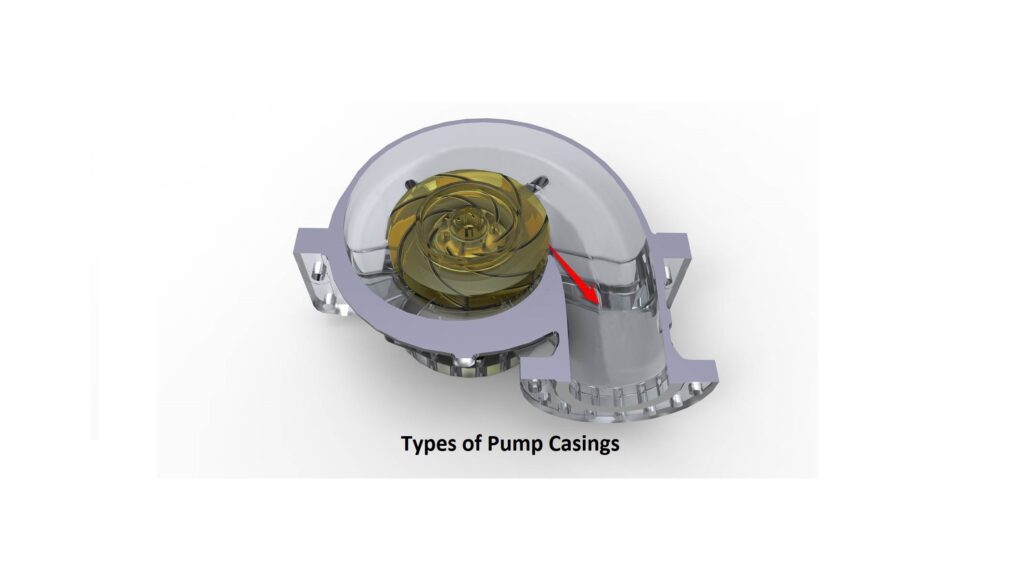Types of Pump Casings – When pump flow rates are at or below the best efficiency point (BEP), casing type can have a significant influence on pump dependability (mean time between repairs) and to a lesser degree, pump efficiency. Hence, choosing the best types of pump casings is very important in plumbing systems. Although it is generally the goal of many pump applications to run the pump at its BEP, this is not always the case owing to:
- When purchasing a pump, the present pump system friction head is not precisely determined.
- Excessive safety criteria were incorporated into the pump selection process to account for future pump wear.
- During normal operation, changes in the system’s static and/or friction head
- Over time, the pump will wear out.
- Over time, changes and/or increases in the system friction head
With Linquip, we are able to supply all the information you need to know about the casings of various types of pumps. Linquip’s experts are always ready to assist you when you need expert advice regarding pump casings. So do not hesitate when you need professional advice. If you would like to acquire a basic understanding of pump casings, it is recommended that you read Linquip’s article titled “What is Pump Casing?“.
Are you familiar with pump casings? We aim to help you find the right pump casing that meets all of your needs by offering a wide selection of Pump Casing Products in Linquip. Are there any specific types of pump casing you need? We offer free access to all available Pump Casings for Sale on the market. Furthermore, should you be interested in finding out the price of Pump Casings that are available in the market, and then through Linquip, you can submit an inquiry/request for quotes to all the Pump Casing Suppliers and Companies for free.
⇒ View a List of Pumps for Sale and Their Suppliers ⇐
What is Pump Casing?
The exterior shell of the pump is referred to as the pump casing. In terms of pressure and fluids, it must seal off the inside of the unit from the outside. Depending on the kind of pump, the casing has a different construction. The infeed and delivery of the flow to the impeller define the casing of a centrifugal pump. The casing is also given special consideration for these pumps since the distance between the casing and the impeller determines the pump’s efficiency.
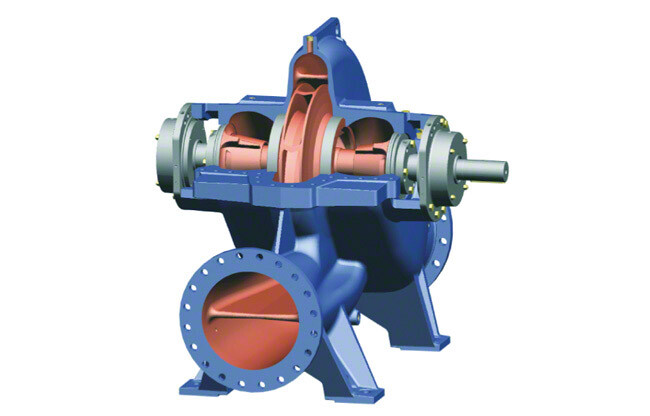
The displacing parts, such as the piston, are enclosed in the casing of a positive displacement pump. In practice, the form of a pump’s casing may already tell you what sort of pump it is. Pump casings can be built of cast or wrought iron, chromium steel, or duplex steel, depending on the use. A plastic enclosure can also be seen on certain pumps.
What Is Casing in Centrifugal Pumps?
The purpose of the casing of a centrifugal pump is to prevent leakage and maintain pressure by sealing the inside of the pump to the atmosphere. They surround the pump rotor, which delivers energy to the fluid handled through the impeller positioned on the spinning shaft, in the case of centrifugal pumps. The component that “contains” the pump is commonly referred to as the “casing.” In practice, the casing of a pump serves five purposes:
- It will keep the pressure in check.
- Incorporate the collector as a separate component or as an intrinsic element of the casing.
- Allow for the installation and removal of rotors.
- Provide structural support for the pump or a structural link to the pump’s support.
- Under the influence of pressure and suitable pipe loads, keep the pump and its rotor aligned.
Types of Pump Casings in Centrifugal Pumps
A centrifugal pump has three types of casing, which are detailed below:
- Volute casing
- Vortex casing
- Casing with guide blades
Volute casing
It’s a spiral kind with a progressive rise in flow area. The velocity of flow reduces as the area of flow increases. The pressure of water flowing through the casing increases as the velocity of the water decreases. The most frequent form of the casing is volute casing. The most popular form of the centrifugal pump is the volute casing pump. The volute-shaped pump casing, which is typical of single-stage centrifugal pumps, is a distinguishing feature.
Vortex casing
The term “vortex casing” refers to a casing with a circular chamber between the casing and the impeller. Vortex casing improves pump efficiency by minimizing the production of eddies to a large amount.
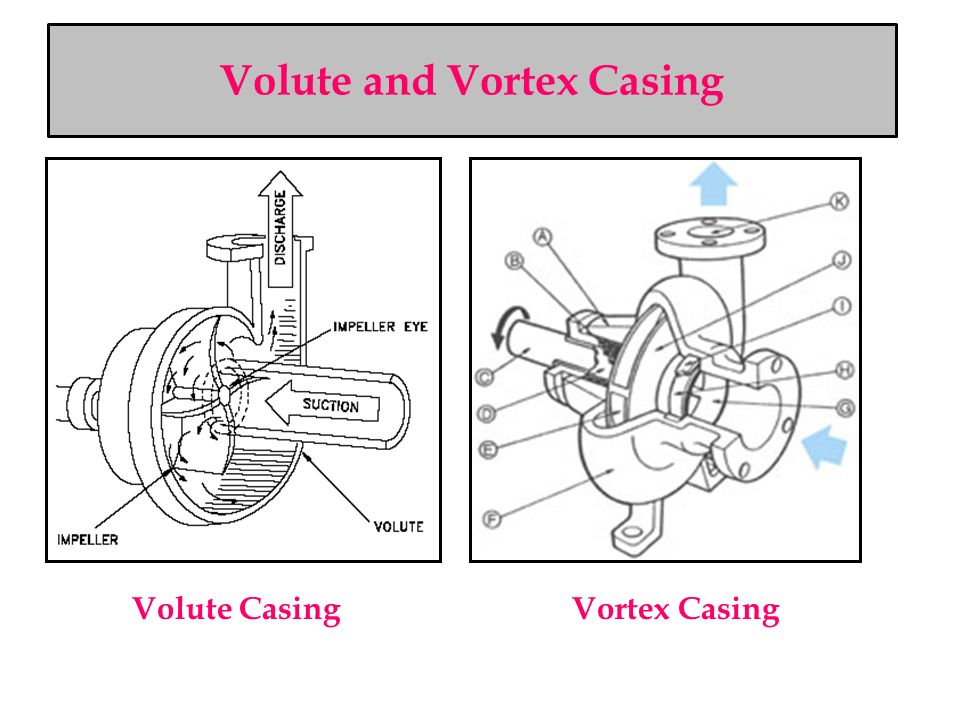
Casing with Guided Blades
The impeller is encircled by a set of guide blades in the casing with guided blades. The guiding blades are attached to a ring known as a diffuser. The guiding vanes are designed in such a way that the water exiting the impeller enters the guides without being shocked.
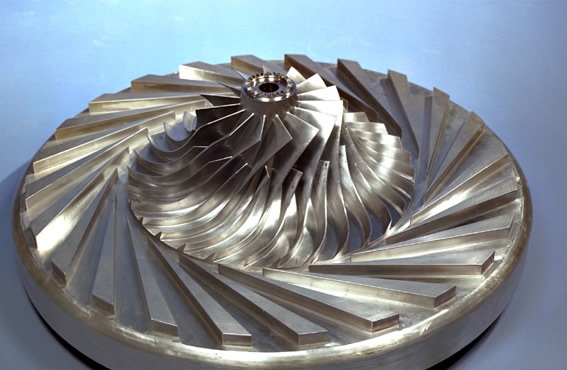
The area of the guiding vanes expands, which serves to reduce the liquid’s velocity while increasing its pressure. Water travels through the surrounding casing after passing through the guiding vanes. The casing remains concentric with the impeller in the vast majority of cases.
Other Different Types of Pump Casings
Other Different Types of Pump Casings include:
- Single Volute Casing
- Double Volute Casing
- Vaned Diffuser Casing
The casing is the pump’s main fixed component, and it serves two purposes:
- Converting the impeller’s velocity head to a pressure head and guiding the flow to the discharge connection
- Creating a pressure barrier for the liquid that is being pumped
A volute is a term used to describe a pump casing. A volute is a spiral-like design that reduces fluid velocity while boosting static pressure by increasing the through-flow area. The impeller fluid is distributed towards the casing discharge nozzle after departing the impeller. There are two types of volute casings: single volute and double volute.
The single volute, double volute, and vaned diffuser are the three most common casing styles for centrifugal pumps. The single volute is the most frequent – at least for low- to medium-flow, single-stage pumps – with twin volutes being more typical for bigger, single-stage pumps handling liquids without solids and vaned diffusers being more common for multistage pumps.
In terms of bearing and shaft seal life, pump efficiency, and pump cost, each of these casing designs has benefits and disadvantages. Although pump users may not always have a choice in casing type, there are several situations where at least some suppliers may provide this option. As a result, it is advantageous for pump users to be aware of the implications of various alternative casing choices.
Single Volute Casing
The impeller discharges into a single volute that wraps entirely around the impeller in a single volute casing. This style of the casing has a single cutwater that directs the liquid flow towards the pump’s outlet.
Single volute pumps have been around for a long time. The bulk of single-stage pumps constructed in the United States are single volute pumps, with the exception being vertical turbine pumps. Given the open spaces surrounding the impeller perimeter, the major advantage of the single volute casing is its simplicity: it is easier to cast and hence less expensive to build. Single volute casings are more efficient than double volute casings at flow rates around the pump BEP. Furthermore, the bigger throat regions can handle heavier particles, such as those present in wastewater.
The volute scroll is engineered to maintain a constant velocity near the optimum efficiency flow rate, resulting in a uniform static pressure across the impeller’s periphery but only at the BEP. When the pump is working at flow rates below or above the BEP, however, this pressure balance is lost. The pressure distribution around the impeller in a single volute at zero flow rate is shown in the diagram below, where A represents an overall reaction, B shows reaction on side shrouds, C represents reaction on impeller perimeter, and D represents non-uniform fluid momentum.
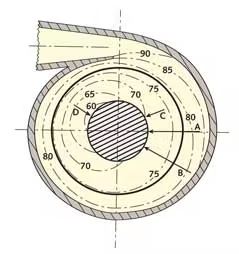
Increased net radial stresses on the rotor arise from this off-BEP, non-uniform pressure distribution around the impeller. Similarly, increasing load deflects the pump shaft, causing excessive wear on the wearing rings, seals, and bearings. Shaft breaking due to fatigue can occur in severe circumstances.
This pressure imbalance around the impeller (at least in a single volute) is often the dominant load on the pump bearings, especially at off-design flow levels. Because the antifriction (ball or roller) bearing life is a function of the cube of the radial load, the impact of this uneven pressure force on bearing L10 fatigue life is exacerbated. This means that the bearing life decreases rapidly as you go away from the BEP. The statistical (L10) ball bearing life ratings are based on metal fatigue failure, with 90% of bearings surviving for the specified duration.
The only approach to extend the bearing life of single volute pumps is to run them as near to the pump BEP as possible for the application, maybe by adding a bypass line from the discharge header to the suction pipe. This can, however, lower the total pump efficiency for the resultant net flow rate.
Double Volute Casing
Two cutwaters are positioned 180 degrees apart in double volute casings. A double volute pump may usually be detected by looking down the discharge flange: inside the nozzle, a visible vane splits the inner diameter of the discharge nozzle.
To solve the radial thrust concerns associated with the single volute design, double volute casings were devised. However, test results show that, while radial forces in a double volute are significantly decreased, they are not entirely eliminated.
The major benefit of a double volute over a single volute is the radial load balancing on the impeller since the double cutwater structure results in a more evenly distributed pressure in the volute. Bearing failures are the second most prevalent cause of pump failures, therefore, reducing the radial stress on the bearings across the whole operating range can have a major influence on the pump’s lifetime. A double volute, on the other hand, increases more hydraulic resistance.
The flow is separated into two equal streams in a double volute casing by two cut-waters that are 180 degrees apart. The overall throat area of the two volutes is equivalent to that of a single volute design of comparable size. As a result, a double volute casing is essentially a single volute with a splitter vane extending 180 degrees from the single volute throat and welling into the diffuser section, resulting in two equal scrolls with a constant velocity at the pump BEP.
At off-BEP flow rates, the two volute sections still produce non-uniform pressures around the impeller, but they tend to cancel each other out to a great extent. The use of a double volute case is primarily for this purpose.
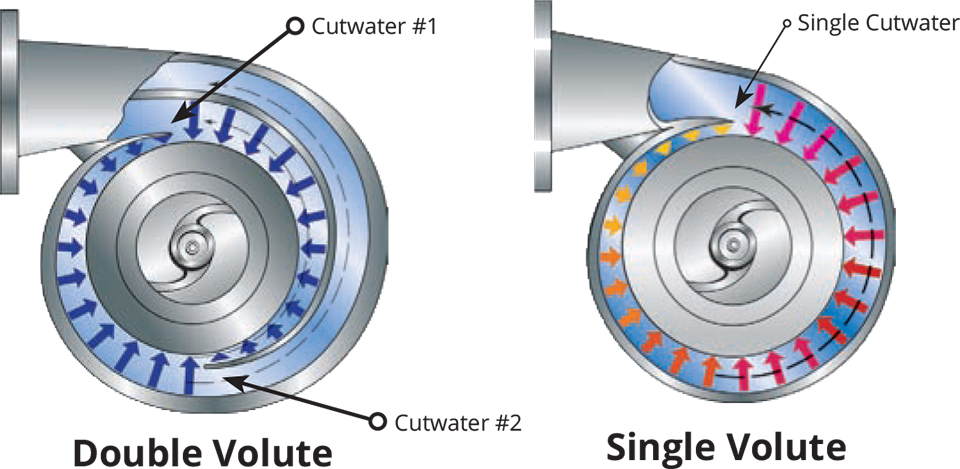
Double volute pumps roughly have the same hydraulic performance as single volute pumps. Based to tests, a double volute pump will be one to one-and-a-half points less efficient at the BEP than a comparable single volute pump but will be two points more efficient on either side of the BEP. This means that a double volute casing will have a little better efficiency than a single volute casing across the complete range of the head-capacity curve.
Larger-axial, split-case, twin-suction impeller pumps with lower axial impeller loads are more likely to feature two volutes. Smaller, low-flow pumps should not employ double volute casings (below about 400 gpm). Larger pumps are better candidates for two volutes, therefore, when available and if the application allows, they should be chosen for this function. When handling particles, such as in wastewater applications, the splitter vane of a double volute might induce obstruction, which would limit their usage in these applications.
Vaned Diffuser Casing
Aside from single and double volute casings, the diffuser casing is another form of the pump casing. Click here to know them precisely. Vertical turbine and multistage, high-head pumps with vaned diffuser casings are commonly utilized for optimal pump dependability and when high efficiency is critical. A vaned diffuser pump’s high efficiency isn’t its sole benefit. The impeller discharges into a uniform ring of nozzles in the vaned type, resulting in totally balanced radial stress on the impeller (meaning zero radial load over the full flow range).
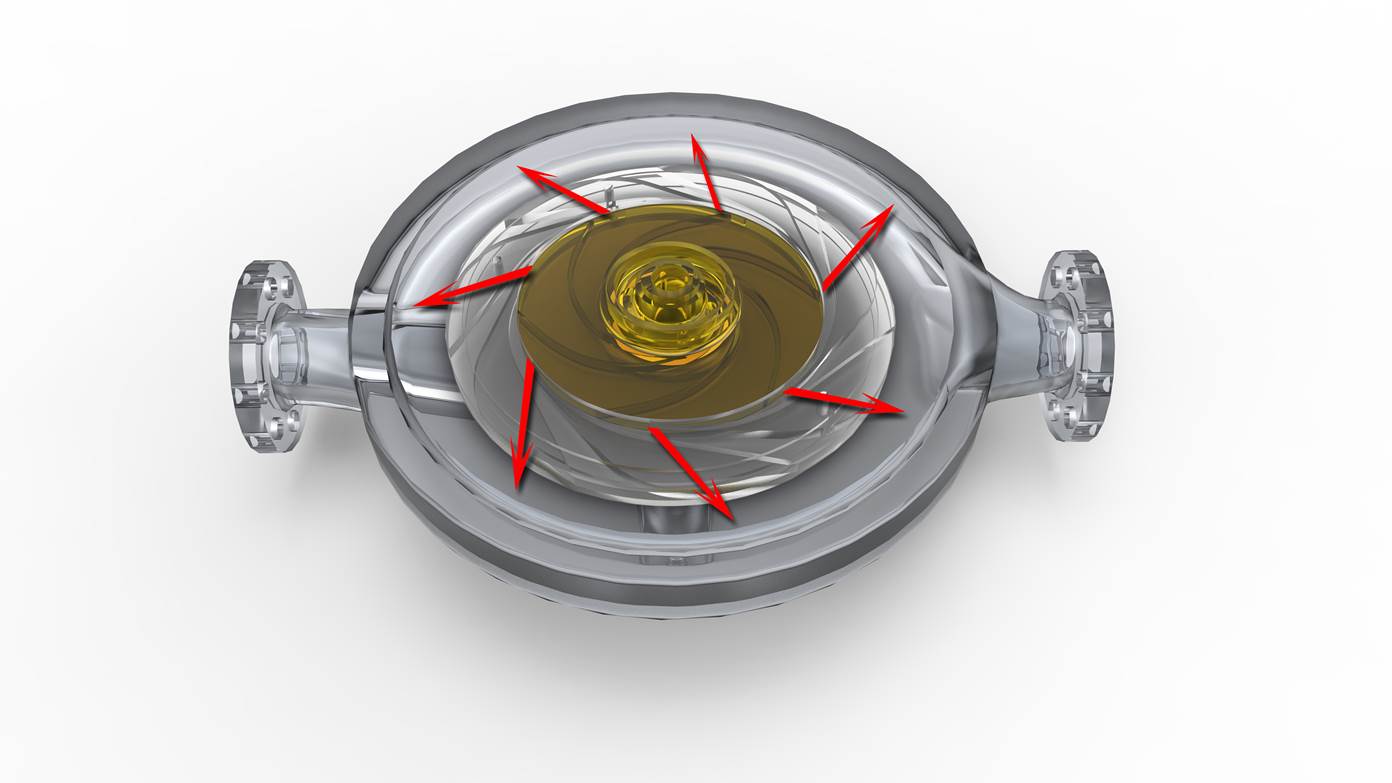
The vaned diffuser pump’s runner is encircled by gradually expanding channels generated by stationary guiding vanes. The velocity head of the liquid exiting the impeller is translated more fully into pressure in this style of the casing than in the volute type, potentially increasing its efficiency marginally. Except in vertical-turbine and big, high-pressure pumps, the increased expense and more sophisticated design of the vaned diffuser pump, when compared to a single volute, is often not regarded as reasonable for the efficiency improvement alone.
What Are the Different Materials That Are Used to Construct Pump Casings?
The casing of the pump is made of duplex stainless steel (50% ferrite and 50% austenite). Since cast steel has a higher strength when it is subjected to pressures greater than 16MPa, it is more common to find pressure-bearing parts made of cast steel.
Download Types of Pump Casings PDF
You can download this article in the form of a PDF file, which we have provided for your convenience. All you have to do is click on the following link to access the document.
Summary
Bearing failures are the second most common cause of pump failures, with mechanical seals being the most common cause. Bearing failures are the second most prevalent cause of pump failures, with mechanical seals being the most common reason. Keeping the radial stress on the impeller at a minimal value across its complete flow range by the selection of a given casing type can have a substantial influence on pump life. Pump operating at off-design circumstances may nevertheless be undesirable due to the adoption of a low radial load double volute or vaned diffuser casing.
Other reasons for operating a pump near to its BEP include improving pump efficiency or avoiding damage from low-flow operation in suction recirculation, as discussed in many of Linquip other posts. If you have any other questions about different types of pump casings, contact Linquip pump casing experts.
Buy Equipment or Ask for a Service
By using Linquip RFQ Service, you can expect to receive quotations from various suppliers across multiple industries and regions.
Click Here to Request a Quotation From Suppliers and Service Providers
Read More on Linquip
- Pump: Working Principles, Function & Diagram
- Different Types of Pumps: Ultimate Guide in 2022
- Types of Fire Hydrant Systems
- 3 Types of Oil Pumps + Working Principle & PDF
- 5 Main Types of Fuel Pump & How They Works?
- Top Dosing Pump Manufacturers and Suppliers in 2022
- Top Water Pump Manufacturers and Suppliers in 2022
- The 7 Best RV Water Pump In 2022 (Clear Guide + Review)
- The 10 Best Electric Air Pump in 2022 (Clear Guide)
- The Best HVAC Vacuum Pump in 2022 (Clear Guide)
- 9 Different Types of Rotary Pumps + PDF
- The 5 Best Well Pump in 2022 (Clear Guide)
- The 10 Best Condensate Pumps of 2022: A Complete Guide
- 13 Parts of Concrete Pump with Name & PDF
- 5 Types of Concrete Pumps + PDF
- Different Types of Pumps: Ultimate Guide in 2022
- Types of Piston Pumps
- 3 Types of Heat Pump + Working Principle ( Clear Guide)
- Types of Pump Casings (In Centrifugal Pumps & Others) + Pros & Cons
- Types of Centrifugal Pumps: All Classification & Working Principles

